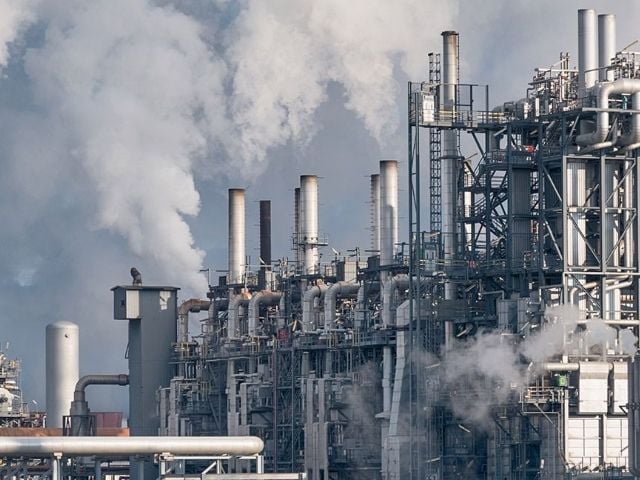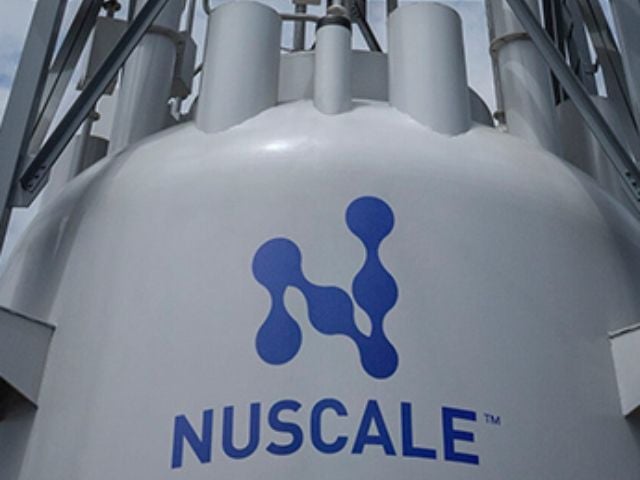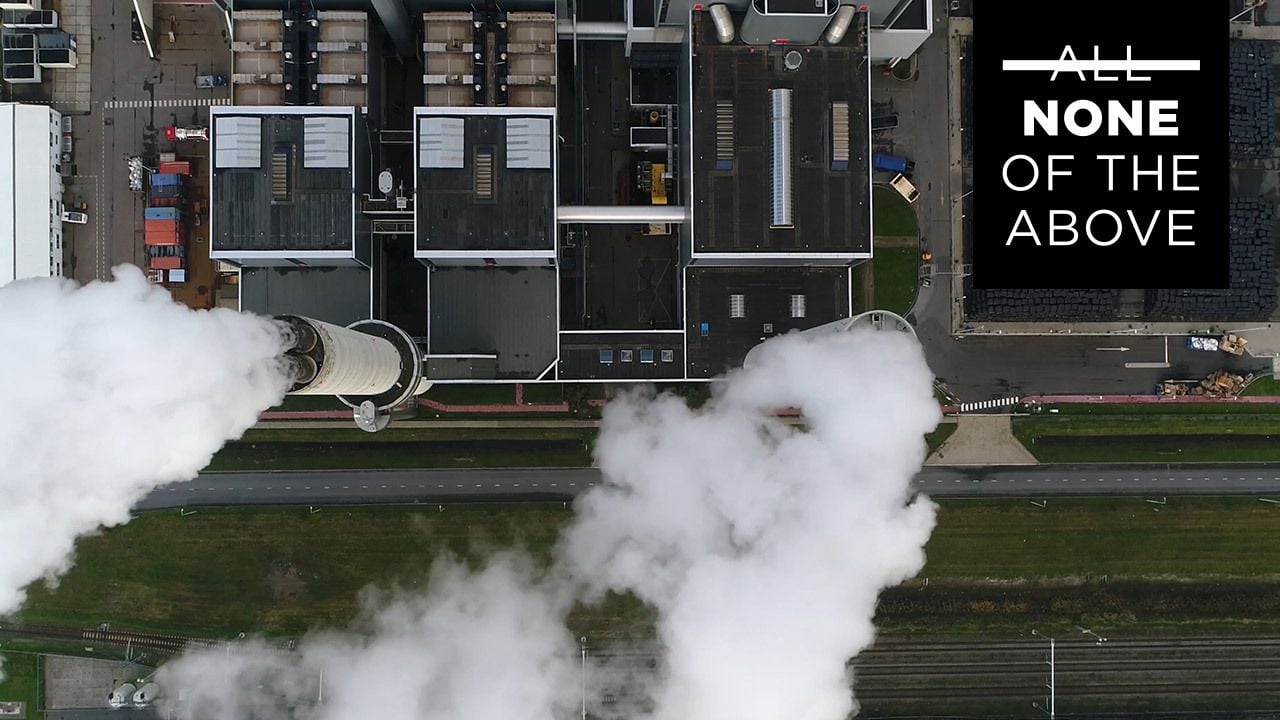
Fifth in a series.
The world is confronting a climate emergency. Avoiding climate catastrophe requires immediate and dramatic reductions in greenhouse gas emissions that are possible only with a significant investment of public resources in proven mitigation measures, beginning with eliminating fossil fuel use and halting deforestation. Carbon capture and storage, or CCS, and carbon capture, utilization and storage, or CCUS, will not address these core drivers of the climate crisis or meaningfully reduce greenhouse emissions, and should not distract from real climate solutions.
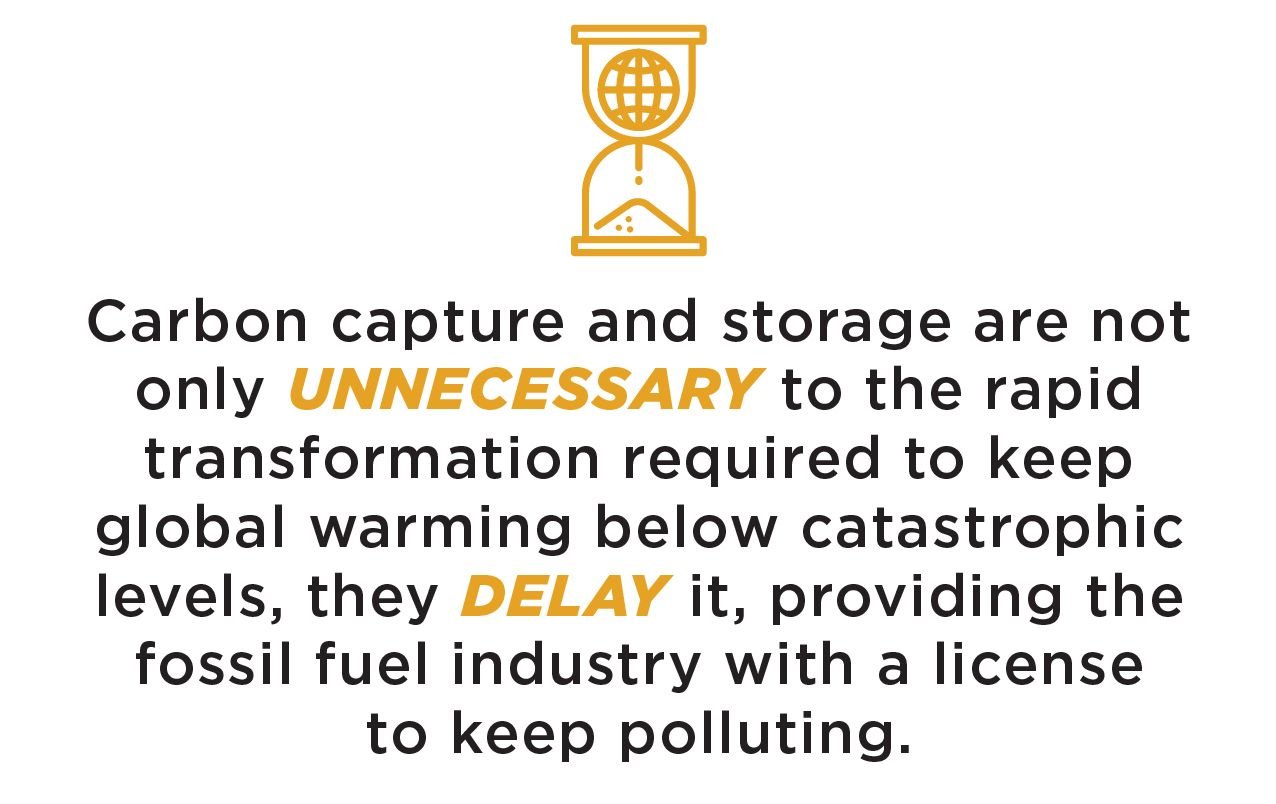
Carbon capture and storage technologies are not only unnecessary to the rapid transformation required to keep warming under 1.5 degrees centigrade, they also delay that transformation, providing the fossil fuel industry with a license to continue polluting. This brief argues that carbon capture and storage:
- Does not remove carbon from the atmosphere, and it worsens the climate crisis when used to boost oil production.
- Has not been proven feasible or economic at scale and can only contain a fraction of source emissions.
- Prolongs dependence on fossil fuels and delays their replacement with renewable alternatives.
- Creates environmental, health and safety risks for communities saddled with CCS infrastructure, such as pipelines and underground storage.
CCS isn’t carbon negative, or even carbon neutral
CCS and CCUS refer to processes that collect or “capture” carbon dioxide generated by high-emitting activities – such as coal- and gas-fired power production or plastics manufacturing – and then transport those captured emissions to sites where they are either used for industrial processes or stored underground.[1]
CCS does not remove carbon from the atmosphere, although it is often erroneously conflated with “carbon dioxide removal” or “negative emission” technology. At best, CCS prevents some emissions caused by the combustion of carbon-based fuels from reaching the atmosphere – provided that the captured gases are not later released.
In practice, however, CCS masks the harmful carbon emissions from the underlying source, enabling that source to continue operating rather than being replaced altogether, while creating additional risks, impacts and costs associated with the CCS infrastructure itself. Moreover, the injection of captured carbon into oil wells to enhance oil recovery – the most pervasive use of CCS today – exacerbates global warming by boosting oil production and prolonging the fossil fuel era.[2]
Large-scale CCS is neither viable nor necessary
The unproven scalability of CCS technologies and their prohibitive costs mean they cannot play any significant role in the rapid reduction of global emissions necessary to limit warming to 1.5 C. Despite the existence of the technology for decades and billions of dollars in government subsidies to date, deployment of CCS at scale still faces insurmountable challenges of feasibility, effectiveness and expense.
- Existing CCS facilities capture less than 1 percent of global carbon emissions.
The 28 CCS facilities currently operating globally have a capacity to capture only 0.1 percent of fossil fuel emissions or 37 megatons of CO2 annually. Of that capacity, just 19 percent, or 7 megatons, is being captured for actual geological sequestration.[3] The great majority, as discussed below, is being used to produce more oil.
- CCS pilot projects have repeatedly overpromised and underdelivered.
The Petra Nova carbon capture facility installed at a coal-fired power station near Houston in 2017 illustrates the failure of CCS to deliver meaningful emissions reductions and the folly of deploying CCS in service of fossil fuel extraction and use.
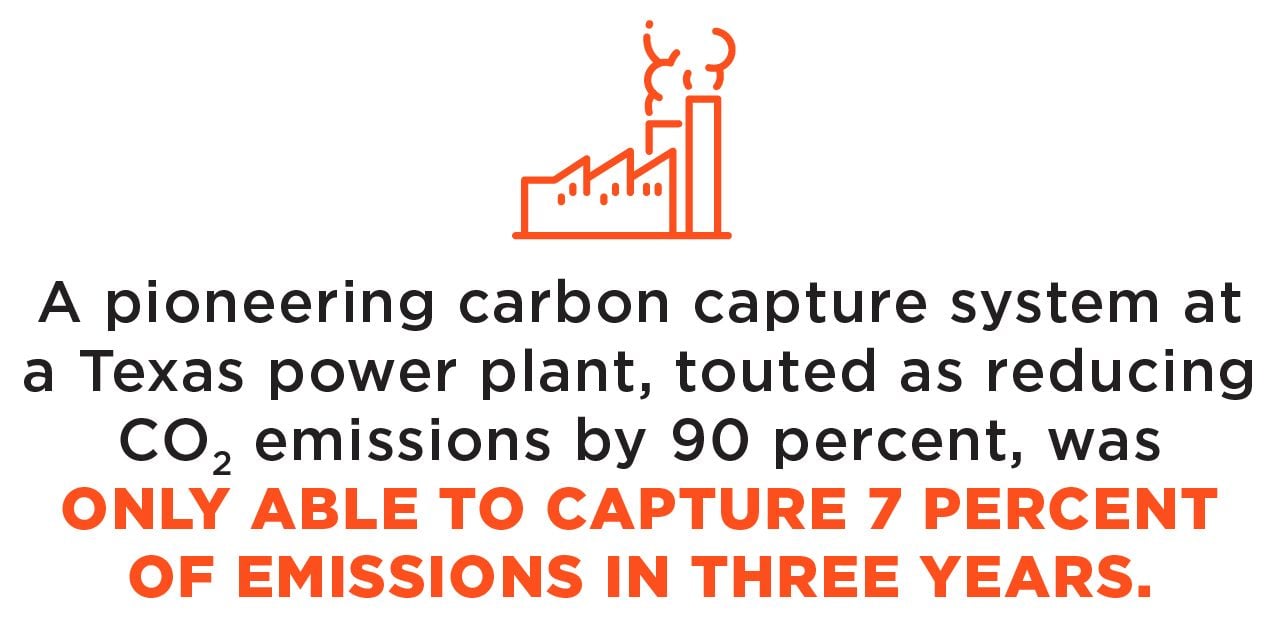
During its operation, the carbon capture system captured only 7 percent of the power plant’s total carbon dioxide emissions – well below the company’s promises to reduce CO2 emissions by 90 percent.[4] The captured carbon from Petra Nova had been used for enhanced oil recovery, but the 2020 collapse in oil price and demand rendered this uneconomic. The CCS operation and the gas plant used to power it have been shut down indefinitely, leaving the coal-fired plant as emission-intensive as ever.[5]
- The surest approach to avoiding climate catastrophe does not involve CCS.
According to the Intergovernmental Panel on Climate Change, or IPCC, the emissions reduction pathway with the best chance of keeping warming at or below 1.5 C makes limited to no use of engineered carbon capture technologies. This pathway involves a rapid phaseout of fossil fuels along with limited carbon removal by natural sources such as reforestation and enhanced soil carbon uptake.[6] The IPCC points to “uncertainty in the future deployment of CCS”[7] and cautions against reliance on the technology, given “concerns about storage safety and cost”[8] and the “non-negligible risk of carbon dioxide leakage from geological storage and the carbon dioxide transport infrastructure.”[9]
In January 2021, the 1,500 member organizations of Climate Action Network International adopted a shared position statement that the largest network of climate organizations worldwide “does not consider currently envisioned CCS applications as proven sustainable climate solutions.” The organizations warned that CCS “risks distracting from the need to take concerted action across multiple sectors in the near-term to dramatically reduce emissions.” Accordingly, CAN urged that “[a]ll government subsidies, loans, grants, tax credit, incentives, and financial support for fossil fuels and technologies that use or otherwise support the continued use of fossil fuels, including CCS, should be phased out as soon as possible.”[10]
- A 1.5 C pathway is possible without CCS.
By transitioning the transportation, industry and building sectors to 100 percent clean, renewable energy through rapid electrification and phaseout of fossil fuels, and enhancing natural carbon sequestration through improved land management and restoration, it is possible to keep warming at or below 1.5 C without CCS.[11]
- Clean energy is also cheaper energy.
Plummeting renewable energy costs are rapidly making electrification with clean sources like solar and wind less expensive than producing power with fossil fuels.[12] A 2020 analysis by Bloomberg New Energy Finance found that solar and wind are already the cheapest energy sources for two-thirds of the world’s population. Rapidly declining costs make renewable energy cheaper than continuing to operate existing coal and gas facilities in many places.[13]
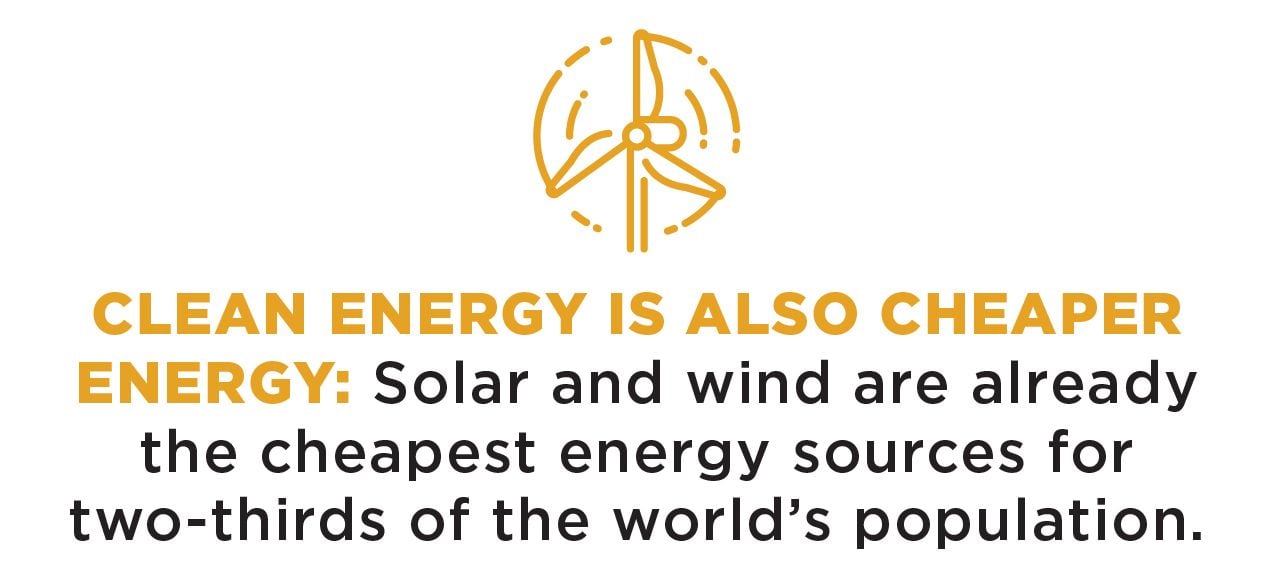
Similarly, plummeting costs are quickly making battery storage a cheaper option than new gas peaker plants for ensuring grid reliability.[14] The federal Energy Information Administration projects that renewables will account for 71 percent of new U.S. electricity generating capacity in 2021.[15]
The failure to account for the energy transition’s market and technological disruptions to coal- and gas-fired power plants means not only that they are outcompeted by alternatives and systematically overvalued[16] but also that “the overwhelming majority of these conventional facilities will become financially unviable and their assets stranded over the next decade or so.”[17] Tacking CCS onto these soon-to-be stranded power plants is as ill-founded economically as it is environmentally unsound.
- From a purely economic perspective, CCS does not make sense.
Economists and energy analysts note that CCS projects are “prohibitively expensive compared to other greenhouse gas emissions mitigation options, such as renewable energy and energy storage technologies.”[18] Adding CCS onto a fossil-fueled power plant inevitably makes operating the underlying source more expensive. As the authors of the energy transition study summarized above observed, “Coal and gas power plants with integrated carbon capture and storage (CCS) are doubly mispriced (overvalued).”[19] With coal- and gas-fired power stations already becoming more costly than renewable alternatives, adding CCS simply makes them even less economic and even less necessary.
A recent assessment of the economic viability of using CCS with gas-fired power plants demonstrates this reality, noting that mature carbon capture technologies are poorly suited to gas and pose an even larger energy penalty for fossil gas than for coal.[20] For a new-build gas-fired plant, CCS could more than double the construction costs and increase the cost of energy produced (known as levelized cost of energy) by up to 61 percent.[21]
As a result, CCS is not economic for gas-fired power plants, even when it takes full advantage of existing federal subsidies, as discussed below, and when the captured carbon is used to produce more oil.[22] The study authors’ proposed solution is to inject even more federal funding into CCS.
The simpler, surer and cheaper solution is to end this and similar subsidies for the fossil economy and invest the savings in accelerating the transition to clean energy.
Even for the hard-to-decarbonize industrial sector, CCS is not the answer
The industrial sector accounted for 27 percent of U.S. greenhouse gas emissions in 2019.[23] As the rationale for wide CCS deployment in the energy sector rapidly fades, CCS proponents are increasingly arguing that CCS will be needed to reduce emissions in heavy-emitting industries like steel, cement, petrochemicals and aluminum.
Although the challenges of decarbonizing these industries are real, the potential for CCS to contribute to major emission reductions is routinely and often dramatically overstated. All too frequently, the advocacy for industrial CCS overlooks or downplays considerations such as cost, alternatives to fossil fuel inputs and the risks posed by transporting and storing captured carbon underground.
- Applying CCS to high-emitting industrial activities, like petrochemical, steel or cement manufacturing, is not economical.
Greenhouse gas emissions from these industries come from a diverse array of sources – including electricity consumption, on-site fossil fuel combustion and process emissions – that make installing and operating CCS even more complex and generally more costly than it is in the power sector.
A recent analysis co-authored by a Chevron researcher highlights how these costs and complexities weaken the case for significant CCS deployment in the industrial sector. Beginning with a candidate pool of more than 1,500 U.S. industrial facilities identified by the Environmental Protection Agency, the researchers immediately eliminated nearly 700 facilities, accounting for roughly half of all U.S. industrial emissions, because the industries involved – including oil, gas and coal production – “are not suitable for carbon capture retrofit.”[24] By contrast, a transition away from fossil fuels would dramatically curtail such emissions.
From the remaining 656 facilities, the researchers identified only 123 – less than 10 percent of the 1,500 facilities in the initial pool – that could capture carbon economically, even with full use of available federal subsidies and enhanced oil recovery.[25] Even among that handful of facilities, many major sources of greenhouse emissions could not be captured.
For example, the petroleum refining industry is the largest source of industrial emissions other than fossil fuel production itself, yet less than 19 percent of refinery emissions were amenable to carbon capture. For metals processing, including steel, only a quarter of process emissions were amenable to CCS.[26] In total, the researchers identified only 68.5 metric tons of CO2 per year from industrial process emissions that could be economically captured.[27] This represents just 8 percent of all industrial emissions in the U.S.
Even this figure significantly overstates the potential of CCS in the industrial sector, because the analysis excluded the indirect energy inputs that account for the largest single component of industrial sector emissions.[28] The authors did so on the grounds that the energy provided comes from the electrical grid, meaning associated emissions can be reduced more directly through other means, such as renewable energy.
- Renewable sources for electricity and heat can dramatically reduce industrial emissions.
Most industrial sector emissions are created by burning fossil fuels to produce the electricity and heat that power manufacturing processes. Thus, decarbonizing the electricity grid by shifting to renewable sources provides the most direct route to slashing emissions in these industries. For example, the World Economic Forum estimates that 60 percent of carbon emissions from electricity-intensive aluminum production could be eliminated simply by producing that electricity from renewable sources.[29] In March, a report by the International Aluminum Institute agreed that decarbonizing electricity grids provides the surest, most direct and likely most cost-effective pathway to significant emission reductions in this energy-intensive industry.[30]
As currently equipped, the industrial sector uses fossil fuels not only for electricity but also for the heat that fuels industrial processes. Fossil fuel combustion for that heat accounts for about 58 percent of U.S. industrial emissions and about 10 percent of overall global greenhouse gas emissions.[31] Electricity from clean power sources like solar and wind has the potential to provide low-carbon heat to many industrial systems.[32]
Concentrated solar thermal systems, for example, use solar energy for generating heat. One company has demonstrated this system works for reaching temperatures of more than 1,000 C.[33] From the heat used in kilns during the process of making cement[34] to the high energy demand from electricity that goes into producing aluminum,[35] clean sources of electricity could displace fossil fuels consumed in a growing array of industrial processes, dramatically curtailing the largest single source of industrial greenhouse emissions and, with it, the purported benefits of CCS deployment in those industries.
- CCS obscures the role of reduction, reuse and recycling in lowering industrial emissions.
Proponents of industrial CCS routinely ignore that one of the most effective ways to reduce industrial emissions from high-emitting sectors like steel, aluminum and plastics is to reuse existing materials, increase recycling rates and produce less of the virgin material that is the major driver of emissions. This contrast is particularly notable in the case of plastics and petrochemicals, where the fracking boom of the past decade has driven a massive buildout of new plastics infrastructure, even as communities around the world recognize that we need to reduce, not increase, our production and use of disposable plastics.
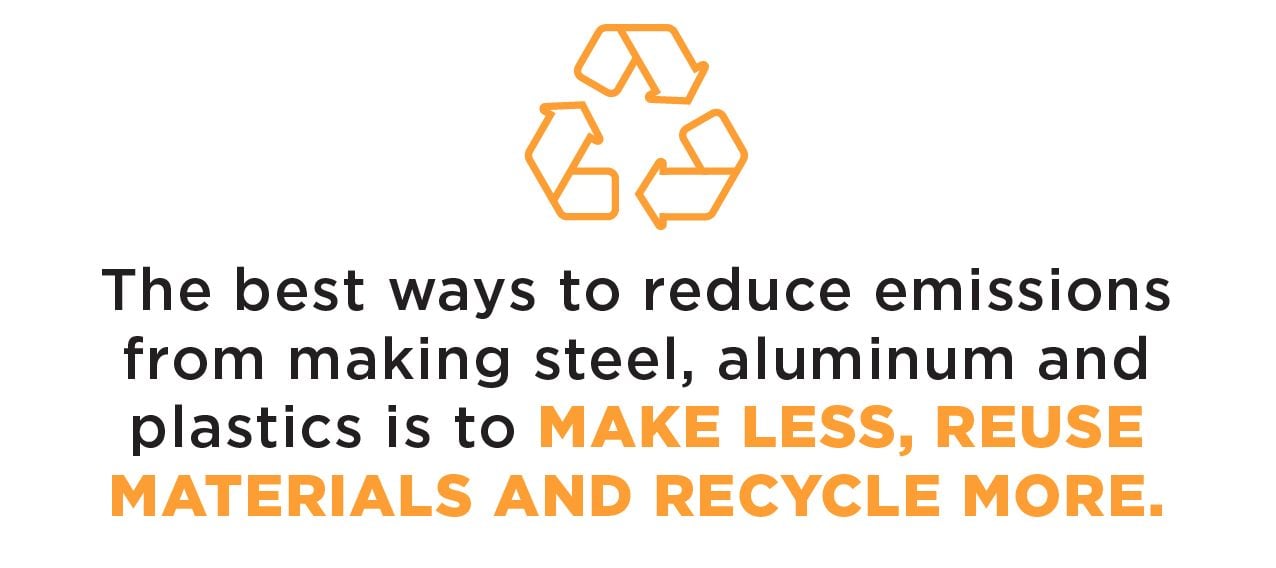
Even for aluminum, which is already heavily recycled, increasing the recycling of scrap metal could avoid 200 million tons of GHG emissions per year.[36] Replacing virgin steel with increased use of scrap metal or direct reduced iron also has a high potential of reducing emissions from steel production – potential that should be tapped, given that, according to industry analysts, CCS technology for steel remains immature and economically unproven.[37]
- Applying CCS to industrial sources requires massive infrastructure buildout.
Even assuming carbon can be captured effectively and economically from an industrial process, that does not ensure it can be safely sequestered. The geographic distribution of CO2 storage sites is a limiting factor for CCS deployment in industry.[38] The overwhelming majority of industrial facilities, including those in high-emitting industries like cement, steel and aluminum, were sited to ensure access to critical resources like steam, electricity, water and end markets, not carbon storage.
Accordingly, only a small fraction of existing or proposed facilities in these sectors are located in areas suitable for CO2 storage. Storing carbon captured from such facilities would demand a vast network of new pipelines, some running hundreds of miles, and carrying hazardous CO2 through populated areas.
- Transporting carbon to storage sites and injecting it underground involves further risks and costs.
As discussed more fully below, this reality means that the growing risks of carbon capture will be borne disproportionately by the few communities already living near concentrations of both heavy industry and potential storage or injection sites.
CCS perpetuates fossil fuel systems and impacts
By design, CCS enables an underlying emissions-generating activity to continue – by capturing some of the carbon dioxide it would otherwise emit. The promise of CCS is being used to rationalize – and subsidize – continued investment in fossil fuel infrastructure that would lock in emissions of CO2 and other pollutants for decades to come.
- Even in its idealized form, CCS only prevents a fraction of emissions from the underlying source.
At every stage of their lifecycle – extraction, refining, transport, use and disposal – fossil fuels release a wide array of pollutants, many of which pose a known or suspected hazard to humans and the environment. For example, a study released by Harvard and University College London researchers in February 2021 found that fine particulate matter, or PM2.5, from burning fossil fuels is responsible for millions of deaths worldwide – in 2018, approximately one in five deaths overall, or 8.7 million premature deaths, were linked to PM2.5 pollution from fossil fuels.[39]
CCS does nothing to address to address these hazards.[40] Indeed, by requiring greater use of fossil fuels to power the CCS process itself, CCS may actually exacerbate them. In the energy sector, there is compelling evidence that the negative climate, environmental and health impacts of adding carbon capture to fossil fuels are substantially greater than simply replacing fossil fuels altogether with clean alternatives.[41] As discussed more fully above, the deployment of industrial CCS raises similar concerns.
- Using captured carbon to produce still more fossil fuels accelerates the climate crisis.
At present, carbon capture is not economically viable without enhanced oil recovery or the production of combustible fuels, making the technology inseparable from the fossil economy. Enhanced oil recovery, or EOR, is a technique through which CO2 – either from natural sources or captured carbon – is injected into underground oil reservoirs to boost oil and gas production from old wells. In essence, CO2 waste products from a fossil fuel-burning activity are used to generate more fossil fuels, propping up the unsustainable fossil fuel energy system.
More than 80 percent of all CCS capacity deployed to date has been used for EOR.[42] And the majority of CCS projects in active development also incorporate EOR. The Department of Energy estimates this could result in up to 48 billion additional barrels of oil used in the U.S. alone by 2030.[43] This is disastrous from a climate mitigation perspective, since it will result in more oil extracted and more carbon emissions from the oil burned. The emissions impact from burning oil produced with CO2 combined with EOR is currently excluded from lifecycle analyses touting the technology.[44] Although the resulting CO2 emissions may be invisible to carbon accountants, their presence in the atmosphere and their impact on the climate remains real and significant.
Proponents of CCUS argue that “[t]he most efficient strategy to reduce the concentration of CO2 in the atmosphere is to convert it to useful chemicals and fuels.”[45] But such proposals confront a fundamental challenge: Global emissions of CO2 are orders of magnitude greater than global demand for CO2 in products. In 2018, the world emitted more than 37 billion tons of CO2 and other greenhouse gases from fossil fuel combustion for energy and industry.[46] By contrast, it used just 230 million tons of CO2 for commercial purposes – equal to just one half of one percent (0.5 percent) of total annual emissions. Two uses alone – EOR and fertilizer production – account for more than 85 percent of all CO2 consumed globally.[47] All other commercial and industrial uses combined account for just 20 million tons of CO2 each year – a mere drop in the bucket.
Nor are the touted uses of CO2 viable. Using captured carbon to produce combustible fuels, including via EOR, defeats any climate purpose, as the fuels release the carbon back into the atmosphere. Transforming CO2 into chemicals requires massive amounts of energy, which is why only a handful of commercialized chemicals use CO2 in significant quantities.[48]
Technologies for embedding captured carbon in plastics, for example, are currently confined to laboratory environments and neither technologically nor economically proven at scale.[49] Just as importantly, using captured carbon to increase production of plastics – which are themselves made from fossil fuels – would compound the plastics crisis while doing little to address the climate crisis.[50]
Proposals to store captured carbon in concrete are no more promising. Storing one pound of CO2 requires 100 times its weight in concrete when embedded in cement mix and more than 1,000 times its weight when embedded in standard concrete blocks.[51] Embedding coal combustion wastes or industrial slag in concrete does not eliminate smokestack emissions and increases risks of toxic leaching from the treated materials.[52] Just as using captured carbon to produce more oil increases emissions, embedding industrial wastes into new products does nothing to curb emissions from the activity that generated the waste.
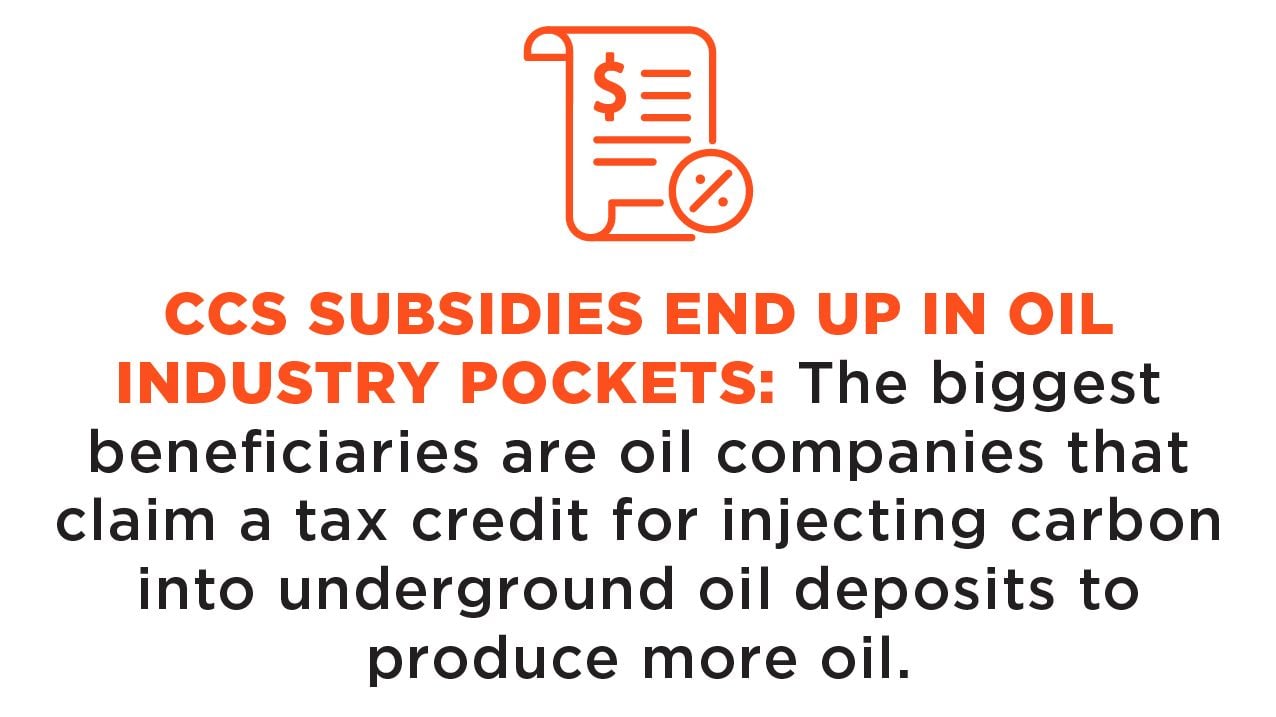
- CCS subsidies end up in oil industry pockets.
The tax credit for CCS projects (under Section 45Q of the Internal Revenue Code, which Congress extended in December) is the main federal policy support for CCS. Its biggest beneficiaries are oil companies that claim the credit for injecting carbon into underground oil deposits to produce more oil, through EOR.[53] The tax credit thus functions as a fossil fuel subsidy.[54]
Moreover, the lack of adequate monitoring of CCS activities means claimed credits may be based on little more than hot air, not stored carbon.[55] For example, an investigation by the U.S. Treasury’s Inspector General for Tax Administration found that fossil fuel companies improperly claimed nearly $900 million in tax credits under Section 45Q.[56]
- The push for carbon capture and storage primarily benefits the fossil fuel industry.
The most vocal and active proponents of CCS are oil and gas, petrochemical and utility companies. They tout the necessity and promise of carbon capture to protect a business model that is contributing to climate catastrophe.[57]
In addition to investing directly in carbon capture ventures, companies in the fossil fuel industry promote CCS advocacy, research and policy through an array of corporate consortia, industry-government working groups and funding partnerships with universities. For example, the Global CCS Institute, an international think tank dedicated to accelerating CCS deployment, includes various coal, oil and gas, and energy and utility companies as members, and a handful of national and sub-national governments.[58] Corporate polluters benefit from promoting CCS, while the environmental and community impacts of scaling up the CCS industry are too often ignored.
CCS poses a growing and poorly understood threat to communities and the environment
Scaling up the technology and infrastructure required to capture, compress, transport and store carbon dioxide entails significant risks.[59] Whether paired with fossil fuel power plants or industrial manufacturing, CCS technology demands massive infrastructure buildout. In terms of scale, it is estimated the CCS industry and associated infrastructure would need to be two to four times larger by 2050 than the current global oil industry.[60] As the IPCC has noted, extensive deployment of CCS “will require a large network of pipelines.”[61] To date, the heavy environmental footprint and safety and health hazards[62] associated with CCS infrastructure have been largely overlooked.[63]
- The transportation of compressed CO2 raises a host of health and safety concerns.
Especially when moved over long distances and/or through heavily populated areas, piping CO2 poses risks similar to those associated with fossil fuel pipelines, from land disturbance and water contamination to the danger of explosions and other accidents. These risks are rarely disclosed or discussed in public discussion of CCS.
Effective transport through pipelines requires that CO2 be shipped at very high pressure and extremely low temperatures, demanding pipelines capable of withstanding those conditions. The presence of moisture or contaminants can make this condensed CO2 corrosive to the steel in those pipelines, increasing the risk of leaks, ruptures and potentially catastrophic running fractures.
Because of the intense pressures involved, explosive decompression of a CO2 pipeline releases more gas, more quickly, than an equivalent explosion in a gas pipeline.[64] Video recordings of pipeline failure tests under controlled conditions demonstrate that even a modest rupture can spread freezing CO2 over a wide area within seconds.[65] The emergence of a running pipeline rupture could extend impacts the entire length of a pipeline segment.[66]
As a paper published by the Institution of Chemical Engineers Symposium cautions: “The combination of the massive amount of CO2 released in a relatively short period of time, the resulting dense cloud followed by solid discharge and its slow sublimation will pose a major challenge to safety practitioners when dealing with the hazards associated with the failure of pressurised CO2 pipelines.”[67]
The IPCC recognizes that “carbon dioxide leaking from a pipeline forms a potential physiological hazard for humans and animals.”[68] These risks take several forms.
The explosive rupture of a pipeline and its associated shockwave pose immediate physical risks to nearby people and property. In areas closest to the pipeline, a release of CO2 can quickly drop temperatures to minus 60 C, coating the surrounding area with super-cold dry ice.[69] At high concentrations, CO2 is a toxic gas and an asphyxiant capable of causing “rapid ‘circulatory insufficiency’, coma and death.”[70] And potential contaminants in CO2 streams, such as hydrogen sulfide, can dramatically compound these risks.[71]
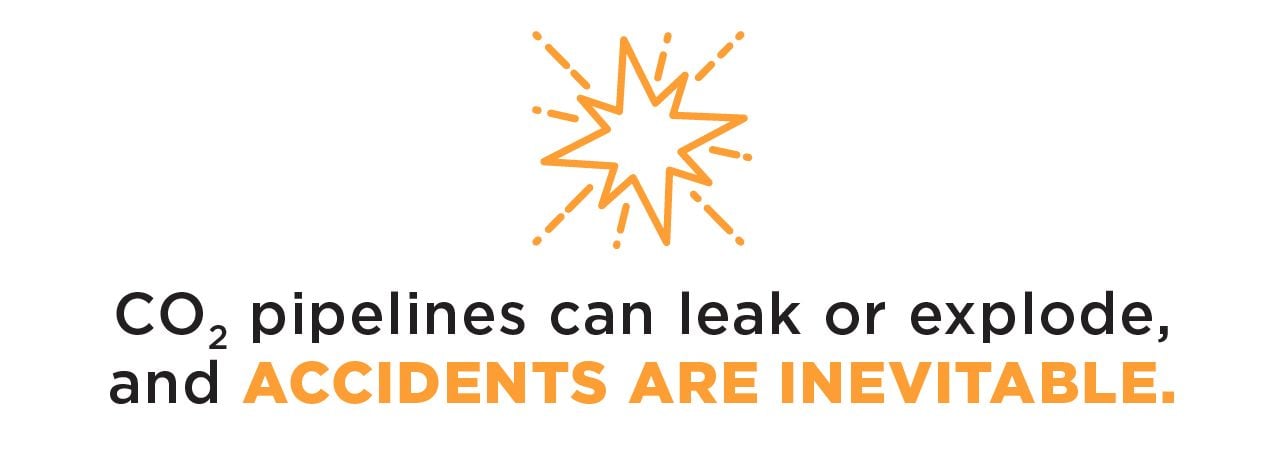
- Accidents are inevitable as CO2 pipelines are increasingly built in populated areas.
In February 2020, a 24-inch high-pressure pipeline containing carbon dioxide and sulfur dioxide ruptured in Yazoo County, Miss. According to the Mississippi Emergency Management Agency, more than 300 residents were evacuated, and 46 people were hospitalized.[72] The pipeline owner, Denbury Enterprises, operates hundreds of miles of CO2 pipelines in the Gulf Coast and Rocky Mountain regions. At least two Denbury pipelines run through the heavily polluted petrochemical corridor known as Cancer Alley,[73] predominately populated by communities of color.
- These safety hazards and environmental risks fall disproportionately on marginalized communities.
Fossil fuel and petrochemical infrastructure and the threats to health and public safety that infrastructure creates already overburden Black, brown and Indigenous communities. The deployment of CCS threatens to significantly increase these risks, particularly in the regions being most heavily targeted for new CCS buildouts.
Both the Gulf Coast of Texas and Cancer Alley in Southern Louisiana have been widely touted as potential epicenters for industrial CCS development due to existing concentrations of oil, gas and petrochemical infrastructure, along with oil fields and salt domes that are the most viable injection and storage sites.[74] CCS proposals in other regions also focus on areas where energy and industrial infrastructure are concentrated, which are typically in or adjacent to poor neighborhoods and communities of color. The expansion of CCS would add a significant new source of pollution and safety risks in Black, brown and Indigenous communities already suffering the disproportionate and deadly impacts of environmental racism.
Conclusion
CCS and CCUS are not only unnecessary, ineffective, uneconomic and unsafe – the technologies are also exceptionally risky, prop up the fossil fuel industry and carbon-intensive industrial activities, and distract from the urgent task of transitioning away from fossil fuels at a time when the U.S. and the world must dramatically accelerate that transition. These technologies, and the dangerous myth they perpetuate of climate-safe fossil fuels, have no place in U.S. climate policies and financing. Such policies should focus instead on phasing out fossil fuels and implementing proven climate mitigation strategies on an urgent, comprehensive basis reflecting their fundamental importance for this and all future generations.
Dana Drugmand is a researcher in the Climate and Energy Program at the Center for International Environmental Law. Carroll Muffett is president and CEO of CIEL. Editorial assistance from Nikki Reisch, Steven Feit and Cate Bonacini of CIEL.
Center for International Environmental Law
1101 15th Street N.W., Washington, D.C. 20005
15 rue des Savoises, 1205 Geneva, Switzerland
www.ciel.org
This is an advance version of a forthcoming CIEL Briefing, and may differ from the final published version. This briefing was prepared by Dana Drugmand and Carroll Muffett of the Center for International Environmental Law (CIEL), with editorial assistance from Nikki Reisch, Steven Feit and Cate Bonacini. Questions regarding the briefing may be directed to the authors at [email protected] and [email protected].
[1] Carbon Capture, Utilization & Storage, U.S. Department of Energy (last visited Feb. 9, 2021).
[2] For a recent scientific review of the climate and environmental impacts of CCS/CCUS in coal and gas-fired power plants, see Mark Z. Jacobson, Evaluation of Coal and Natural Gas with Carbon Capture as Proposed Solutions to Global Warming, Air Pollution, and Energy Security in M.Z. Jacobson, 100% Clean, Renewable Energy and Storage for Everything (2020), https://web.stanford.edu/group/efmh/jacobson/WWSBook/WWSBook.html.
[3] S. Garcia Freites & C. Jones, A Review of the Role of Fossil Fuel-Based Carbon Capture and Storage in the Energy System, Tyndall Centre (2021), at 12.
[4] Joe Smyth, Petra Nova carbon capture project stalls with cheap oil, Energy & Policy Institute (Aug. 6, 2020); Nichola Groom, Problems plagued U.S. CO2 capture project before shutdown: document, Reuters, Aug. 6, 2020; see also nrg, Petra Nova: Carbon capture and the future of coal power (last visited Mar. 17, 2021).
[5] Nichola Groom, Power plant linked to idled U.S. carbon capture project will shut indefinitely - NRG, Reuters, Jan. 29, 2021.
[6] IPCC, Summary for Policymakers in IPCC, Global Warming of 1.5°C: An IPCC Special Report on the impacts of global warming of 1.5°C above pre-industrial levels and related global greenhouse gas emission pathways in the context of strengthening the global response to the threat of climate change, sustainable development, and efforts to eradicate poverty (2018) [hereinafter IPCC SR1.5]G, at 14, Section C.1.1., Figure SPM 3b (Pathway 1); see also IPCC SR1.5, at Ch. 2.3.3 and Table 2.SM.12.
[7] IPCC SR1.5, Ch. 2, Section 2.4.2.3.
[8] IPCC SR1.5, Ch. 4, Table 4.13.
[9] IPCC SR1.5, Ch. 5, Section 5.4.1.2.
[10] CAN Position: Carbon Capture, Storage, and Utilization, Climate Action Network International (Jan. 2021).
[11] Achieving the Paris Climate Goals in the COVID-19 era, F20 – Policy Briefing #2/2020 (Sept. 2020).
[12] Projected Costs of Generating Electricity, 2020 Edition, International Energy Agency and Nuclear Energy Agency (Dec. 2020).
[13] Scale Up of Solar and Wind Puts Existing Coal and Gas at Risk, Bloomberg New Energy Finance (Apr. 2020).
[14] BloombergNEF: ‘Already cheaper to install new build battery storage than peaking plants’, Energy Storage News, Apr. 30, 2020.
[15] U.S. Energy Information Administration, Renewables account for most new U.S. electricity generating capacity in 2021, Jan. 11, 2021.
[16] Jared Anderson, Miscalculated levelized cost of electricity data has overvalued power plants: study, S&P Global/Platts, Mar. 15, 2020 (reporting on Dorr & Seba, infra note 17).
[17] Adam Dorr & Tony Seba, The Great Stranding: How Inaccurate Mainstream LCOE Estimates are Creating a Trillion-Dollar Bubble in Conventional Energy Assets, RethinkX (Feb. 2021), at 7.
[18] Clark Butler, Carbon Capture and Storage Is About Reputation, Not Economics, Institute for Energy Economics and Financial Analysis (July 2020).
[19] Dorr & Seba, supra note 17 at 7, 23.
[20] Peter Psarras et al., Cost analysis of carbon capture and sequestration from U.S. natural gas fired power plants, 54 Environ. Sci. Technol. 6272, 6273 (2020).
[21] Id. at 6274.
[22] Id. at 6277.
[23] US EPA, Draft Inventory of US Greenhous Gas Emissions and Sinks: 1990-2019, at Table 2-5, pp. 2.14-2.15 (published for public review and comment, 86 Fed. Reg. 9339 (Feb. 12, 2021)).
[24] H. Pilorgé et al., Cost Analysis of Carbon Capture and Sequestration of Process Emissions from the U.S. Industrial Sector, 54(12) Environ. Sci. Technol. 7524-7532 (2020) (free version availableat:https://users.wpi.edu/~jlwilcox/documents/Part%202_Industry.pdf).
[25] Id.
[26] Id. at Supporting Information, S8.
[27] Id.
[28]Id. at Supporting Information, S2.
[29] World Economic Forum, Aluminum for Climate: Exploring Pathways to Decarbonize the Aluminum Industry 10 (Nov. 2020).
[30] Int’l Aluminum Inst., Aluminum Sector Greenhouse Gas Pathways to 2050 (Mar. 2021), at 10 & Figure 10.
[31] S. Julio Friedmann et al., Low-Carbon Heat Solutions for Heavy Industry: Sources, Options, and Costs Today 10, Columbia University Center on Global Energy Policy (Oct. 2019), at 10.
[32] Id. at 23.
[33] Darren Quick, Concentrated solar viable for industrial uses after exceeding 1,000°C, New Atlas, Nov. 21, 2019.
[34] Michael Barnard, Cement’s CO2 Emissions are Solved Technically, But Not Economically, CleanTechnica, Nov. 26, 2019.
[36] Int’l Aluminum Inst., supra note 30 at 16.
[37] Christian Hoffman et al., Decarbonization Challenge for Steel, McKinsey and Company (June 2020), https://www.mckinsey.com/industries/metals-and-mining/our-insights/decarbonization-challenge-for-steel.
[38] Friedmann et al., supra note 31, at 12.
[39] Karn Vohra et al., Global mortality from outdoor fine particulate pollution generated by fossil fuel combustion: Results from GEOS-Chem, 195 Envt’l Research (Article 110754) (2021), available online Feb. 9, 2021.
[40] See, e.g., Jacobson, supra note 2, at 3.1.2.
[41] Taylor Kubota, Stanford study casts doubt on carbon capture, Stanford News, Oct. 25, 2019; Mark Z. Jacobson, The health and climate impacts of carbon capture and direct air capture, 12 Energy Environ. Sci. 3567-3574 (2019).
[42] Garcia Freites, supra note 3, at 3.
[43] Dept. of Energy-National Energy Technology Laboratory, Carbon Dioxide Enhanced Oil Recovery: Untapped Domestic Energy Supply and Long Term Carbon Storage Solution (Mar. 2010), at 20.
[44] Carbon dioxide capture, transportation and geological storage – Carbon dioxide storage using enhanced oil recovery (CO2-EOR), ISO 27916:2019.
[45] Subhajyoti Samanta and R. Srivastava, Catalytic conversion of CO2 to chemicals and fuels: the collective thermocatalytic/photocatalytic/electrocatalytic approach with graphitic carbon nitride, Materials Advances. 2020, 1, 1506 at 1508.
[46] Zeke Hausfather, Analysis: Fossil Fuel Emissions in 2018 Increasing at Fastest Rate for Seven Years. Carbon Brief (December 5, 2018).
[47]Novak Mavar, K.Gaurina-Medimurec, N.; Hrncˇevic´, L. Significance of Enhanced Oil Recovery in Carbon Dioxide Emission Reduction. Sustainability 2021, 13, 1800. (Feb. 2021) Manuscript at 3 (Table 1) (showing that 91% of all CO2 used commercially is used for enhanced oil and gas recovery (including enhanced coalbed methane), and fertilizer production).
[48] Gaseous Carbon Waste Streams Utilization: Status and Research Needs (2019) at 63-64. National Academies Press. Available online at https://www.nap.edu/read/25232/chapter/6.
[49] Chui, Glennda. “Fuels, Plastics, and Feedstocks from CO2? They’re Working On It.” SLAC National Acceleratory Laboratory (September 9, 2019). (“We concluded that renewable energy prices would have to fall below 4 cents per kilowatt hour, and systems would need to convert incoming electricity to chemical products with at least 60% efficiency, to make the approach economically competitive with today’s methods.”)
[50] Plastics and Climate: The Hidden Costs of a Plastic Planet at 2-5, Center for International Environmental Law (May 2019).
[51] “CO2 Mineralization – Applications.” Carbon Cure Technologies. https://www.carboncure.com/technology/ (accessed April 16, 2021).
[52] See, e.g., Huang, M., Feng, H., Shen, D. et al. Leaching Behavior of Heavy Metals from Cement Pastes Using a Modified Toxicity Characteristic Leaching Procedure (TCLP). Bull Environ Contam Toxicol 96, 354–360 (2016). https://doi.org/10.1007/s00128-015-1722-2 (reporting standard testing protocols reported lower levels of toxic metal leaching from cement produced using industrial slags than were evident in a modified testing procedure more suited to cement rotary kiln processing products).
[53] Nicholas Kusnetz, Exxon Touts Carbon Capture as a Climate Fix, but Uses it to Maximize Profit and Keep Oil Flowing, InsideClimate News, Sept. 27, 2020.
[54] Janet Redman, Expanding Subsidies for CO2-Enhanced Oil Recovery: A Net Loss for Communities, Taxpayers, and the Climate, Oil Change International (Oct. 2017).
[56] Menendez Releases Inspector General Investigation Finding Fossil Fuel Companies Improperly Claimed Nearly $1B in Clean Air Tax Credits, Senator Menendez News Release, Apr. 30, 2020.
[57] Center for International Environmental Law (CIEL), Fuel to the Fire (2019), at 19-22.
[58] See Global CCS Institute Members, https://www.globalccsinstitute.com/membership/our-members/.
[59] June Sekera & Andreas Lichtenberger, Assessing Carbon Capture: Public Policy, Science, and Societal Need, 5(14) Biophys Econ Sust. (2020), at 11-12, 18-20.
[60] Niall Mac Dowell et al., The role of CO2 capture and utilization in mitigating climate change, 7 Nature Climate Change 243–249 (2017).
[61] IPCC Special Report on Carbon Dioxide Capture and Storage, Chapter 4: Transport of CO2 (2005), at 181.
[62] John Fogarty & Michael McCally, Health and Safety Risks of Carbon Capture and Storage, 303(1) JAMA 67-68 (2010).
[63] Sekera & Lichtenberger, supra note 54.
[64] Haroun Mahgerefteh, G. Denton & Yurii Rykov, Pressurised CO2 pipeline rupture. Institution of Chemical Engineers Symposium Series (2008), at 869-879; E. Aursand et al., Fracture propagation control in CO2 pipelines: Validation of a coupled fluid-structure model, SINTEF Energy Research (2016) (“Compared to natural-gas pipelines, the pressure level at the opening fracture flaps is sustained at a much higher level and at a much longer distance behind the moving fracture tip. This may be one important reason why the existing engineering methods do not work for dense-phase CO2.”).
[65] Dense phase CO2 8" NB pipe rupture, DNV GL.
[66] S.T. Munkejord, Understanding the forces at play when boiling CO2 drives a running pipeline fracture, SINTEF Energy Research, June, 14, 2016; see also video demonstration at same link: https://blog.sintef.com/sintefenergy/ccs/understanding-the-forces-at-play-when-boiling-co2-drives-a-running-pipeline-fracture/.
[67] Mahgerefteh et al., supra note 56, at 869.
[68] IPCC Special Report on Carbon Dioxide Capture and Storage, Chapter 4, p. 188.
[69] See, e.g., Mahgerefteh, supra note 59, manuscript at 10.
[70] Congressional Research Service, Report for Congress--Carbon Dioxide (CO2) Pipelines for Carbon Sequestration: Emerging Policy Issues, Apr. 19, 2007 at 55 .
[71] X. Liu, A. Godbole, C. Lu, G. Michal & P. Venton, Study of the consequences of CO2 released from high pressure pipelines, Atmospheric Environment, 116 51-64 (2015), manuscript at 26 (“If the CO2 stream contains H2S, the H2S may present a greater hazard than the CO2 itself.”).
[72] “Pipeline Ruptures in Yazoo County, Dozens Rushed to the Hospital,” Mississippi Emergency Management Agency, Feb. 23, 2020.
[73] Gulf Coast CO2 Pipelines, Denbury (last visited Feb. 10, 2021).
[74] David Dismukes et al., “Integrated Carbon Capture and Storage in the Louisiana Chemical Corridor,” LSU, Feb. 18, 2019.

